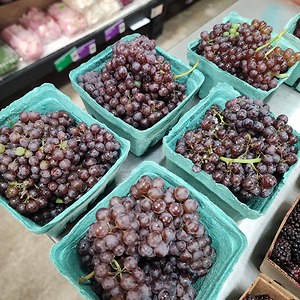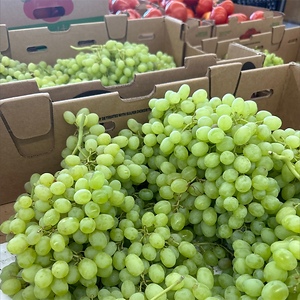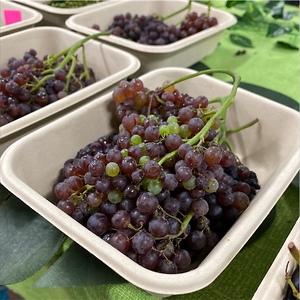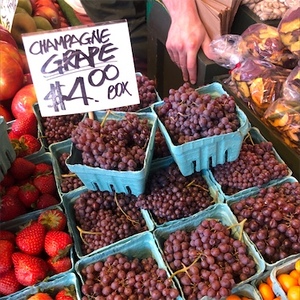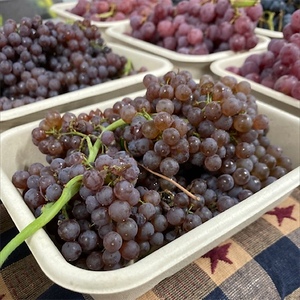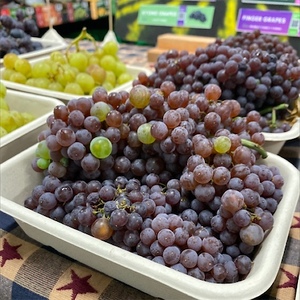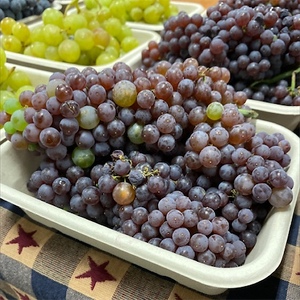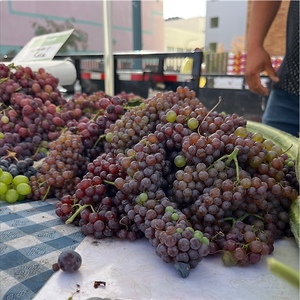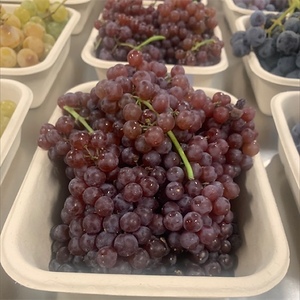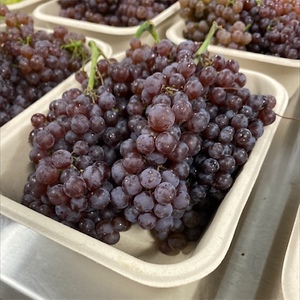


Champagne Grapes
Estimated Inventory, 18 lbs : 0
This item was last sold on : 09/07/24
Description/Taste
Champagne grapes grow in long, tightly packed bunches, averaging 91 to 269 grams in weight, and have a cylindrical, tapered shape. Each grape within the bunch is tiny, about 0.5 to 1 centimeter in diameter, and is similar in size to a pearl or pea. The round grapes have smooth, taut, firm, thin, delicate skin, showcasing variegated hues of dark red, maroon, to red, almost black. The fruit's surface is also covered in a natural, powdery, blue-grey bloom that protects the grapes from moisture loss. The stem of Champagne grapes is edible and can be consumed with the grapes as it is often firmly attached to the fruits. It is said the green stems are thin and indistinguishable from the grape's crisp, popping skin. Underneath the surface, the translucent red-purple to green flesh is aqueous, tender, and succulent. Champagne grapes are also a type of parthenocarpic grape, meaning they do not develop seeds. When ripe, Champagne grapes contain a high sugar content, creating a sweet, sugary taste combined with subtly tart and spice-filled nuances. The grapes can also be dried into raisins, concentrating their sugary flavor.
Seasons/Availability
Champagne grapes are available for a short season in the summer through early fall.
Current Facts
Champagne grapes, botanically classified as Vitis vinifera, are a type of Mediterranean grape belonging to the Vitaceae, or common grape family. The variety is native to Greece and has been cultivated as a fresh-eating fruit and raisin for centuries. Historically, wild Champagne grapes were no larger than the tip of a pen, but over time, growers developed girdling and the plant hormone gibberellic acid to encourage grape vines to produce larger bunches of grapes. Champagne grapes are still one of the smallest commercial varieties, and in Europe, the grapes are known as Black Corinth grapes, Corinth grapes, and Korinthiaki grapes. In the United States, Champagne grapes earned their sparkling wine moniker from a campaign conducted by Allin Corrin, a grape producer from Reedley, California. Corrin frosted the small grapes and displayed them alongside a flute of Champagne in an editorial in Sunset Magazine. After the piece was published in the magazine, American producers decided to rename the grapes to Champagne grapes, as the grapes were said to embody the tiny bubbles in the sparkling beverage. In the modern day, there are multiple types of red, white, and black varieties under the name Champagne, but the black cultivar is the most common. The tightly clustered variety is favored for its sweet taste and is consumed fresh or dried as a novelty.
Nutritional Value
Champagne grapes are a source of vitamin C to strengthen the immune system, vitamin A to maintain healthy organ functioning, and iron to develop the protein hemoglobin for oxygen transport through the bloodstream. The grapes also provide calcium to build sturdy bones and teeth, potassium to balance fluid levels within the body, fiber to regulate the digestive tract, and other nutrients, including vitamin K, vitamin A, and copper.
Applications
Champagne grapes have a sweet, subtly tart taste suited for fresh and cooked preparations. The grapes are traditionally consumed straight out of hand, and the tightly adhered, edible green stems are also eaten for easier consumption. Champagne grapes are commonly used as a decorative element in fruit bowls, food displays, and appetizer platters, and the small grapes are a favored snack food. The grapes can also be served with cheeses, tossed into salads, layered into parfaits, frozen into granita, or used in any other recipe calling for table grapes. In addition to fresh preparations, Champagne grapes can be roasted, baked, or simmered and added to sauces, jams, and jellies, used as filling in baked goods, or added to scones, muffins, and cakes. They can also be dried into raisins and used in sweet or savory dishes. Dried Champagne grapes, known as Zante currants, can be added to fruit cakes, rice, couscous, roasted meats, or other baked goods. In Greece, Champagne grapes are sometimes used to make Mavrodaphne of Patras, a well-known sweet red wine. Champagne grapes pair well with nuts such as walnuts, almonds, or pecans, cheeses including smoked cheddar, goat, ricotta, and gouda, fruits such as coconuts, strawberries, melons, and blueberries, and herbs including parsley, mint, and basil. Whole, unwashed Champagne grapes will keep for 1 to 2 weeks when stored in a ventilated container in the refrigerator. The grapes can also be frozen for extended use.
Ethnic/Cultural Info
Champagne grapes are famously used to produce Corinth raisins, also known as Zante currants. The dried grapes were first cultivated in Greece and were selected for their small size, making them easy to dry and carry as a chewy snack. Zante currants are one of the oldest known raisins and were discovered when growers sampled grapes that had dried on the vines in the fields. Experts believe raisin production began sometime between 120 and 900 BCE, and throughout history, dried raisins were thought to have magical properties, curing sicknesses and old age. Raisins were used as decorations in Greek temples, and in Rome, two jars of raisins were considered valuable enough to trade for a slave. Zante currant cultivation was centralized on the Ionian Island of Zakynthos, located near the Gulf of Corinth, in the early 16th century. This is also where the dried raisins acquired their Zante moniker. During the 17th and 18th centuries, Venetians controlled Zante currant production on Zakynthos, which was later taken over by Napoleon in 1797. Zante currants are still grown in Greece in the modern-day and account for almost 80% of the Zante currants produced worldwide. The dried fruits are cultivated in Corinth, Kefallinia, Illia, Zakynthos, Achaia, and Messinia, and two types of Zante currants, the Corinthian Raisin Vostitsa and the Raisin of Zakynthou, have received a Protected Designation of Origin or PDO, labeling them as specialized crops of Greece.
Geography/History
Champagne grapes are native to Greece and have been growing wild since ancient times. The variety is thought to be a seedless mutation of the Liatiko grape, another cultivar native to Greece, and in the wild, the grapes are much smaller than a pea. Champagne grapes were initially known as Black Corinth grapes, and the variety was first recorded in a written document composed by Pliny the Elder in 75 CE. During the Greek and Roman empires, Black Corinth grapes were cultivated to make raisins and were traded across the Mediterranean. In the 14th century, Corinth raisins were sent to England under the name Reysyns de Corauntz, and the grapes were carried to the United States from Europe in the late 19th century. Colonel Agoston Haraszthy was one of the first individuals to cultivate white and red varieties in California in 1861, and David Fairchild introduced black cultivars around 1901. Champagne grapes became popular throughout the United States in the 1930s, but over time, the grape was forgotten until the variety was revived in the 1980s with the rise of mini vegetables. Today, Champagne grapes are grown worldwide under various names, and when in season, the variety is sold fresh and dried through local markets, direct through vendors, select grocers, and distributors.
Recipe Ideas
Recipes that include Champagne Grapes. One
| Tasty Kitchen |
|
Seared Scallops with Champagne Grapes & Almonds |



